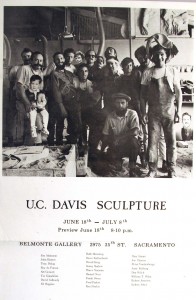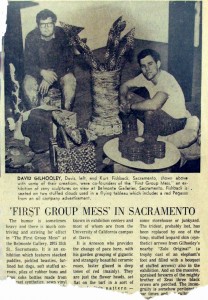Memories of Belmonte
Posted on February 1, 2010 – 11:57 AM | by OldManFosterby Tim Foster

Robert Arneson, Bruce Nauman and the whole TB9 crew posed for this 1965 Belmonte show poster
“You know I think he was always interested in art,” said his wife Masako Yniguez as we spoke in her 12th Avenue home. “After we got married and I think after I was going to have our second child, he went and quit his job at McClellan (laughs). He went to Sacramento college and took classes from people… that’s how he got to know some of the artists.” One of the artists he befriended was a Sac State art teacher, Irving Marcus.
“I was teaching at Sacramento State and Sal was out there and we struck up a friendship,” Marcus remembers. Marcus and Sal became close almost immediately finding kinship in their mutual interest in contemporary art. At around the same time, Yniguez opened the Belmonte Coffee Shop at 2975 35th Street in Oak Park. Artist Fred Dalkey, then a student at Sac City, remembers the Belmonte as a classic beatnik coffee house. “He had music and poetry readings and all kinds of things went on there. I used to play a lot of music, and I used to perform there on a fairly regular basis.” Before long, Yniguez had added artist’s studios and a woodworking shop where he started building frames for his artist friends, including Marcus. In the creative atmosphere, ideas flowed. “We talked about the need for a gallery in Sacramento that showed contemporary work.”

Sal Yniguez with son Chava and daughter Celia, late sixties
With no money and no real idea how to run an art space, Yniguez plunged in, opening the Belmonte Gallery in the same rambling building as the coffee house on December 7, 1962. According to Marcus, the decision was pure Sal. “[He] was just the kind of guy who could go ahead and do it… Boy, was he ever a quick learner.”
The Belmonte Gallery kicked off with a bang. The Inaugural Exhibit was a group show that included Marcus, several local artists and legendary surrealist Gordon Onslow Ford, then based in the Bay Area. That Yniguez was able to land such a high profile artist for the opening show in an unproven Sacramento gallery speaks to his charm. The Belmonte was an immediate hit, and Onslow Ford was the star of the show; Marcus is still impressed. “For an artist of that reputation to be included in that show was quite a big deal.”
By 1963, the Belmonte complex was in full swing, and Sal and Masako had become an integral part of the art community. “City college artists used to have classes at Belmonte Gallery,” remembers Masako. “…We had- what do you call it?.. models without any clothes- live models. City College wouldn’t do that so my husband had them, and the artists would come there.”
The Belmonte filled a void in the city’s art scene, quickly becoming the home of the city’s Avant Garde. Trendsetters like Mel Ramos, Robert Arneson and Wayne Thiebaud (“I can still remember- it was a painting of his wife,” says Masako) showed at the Belmonte along with their students, like Dennis Oppenheim, Steven Kaltenbach and Fred Dalkey. As Pop Art exploded nationally and Arneson began to groom a generation of artists in his UC Davis workshop, Sacramento grew hipper, seemingly overnight. “We were really Beatnik-Hippies,” laughs Masako. “The artists were really far out in those days, which was really nice.”
 Dalkey remembers the 1966 American Institute of Architects Invitational show as perhaps the highlight of the Belmonte’s run. Mike Singer, an architect who arranged the AIA sponsorship, remembers that the idea for the show came from a discussion with Arneson, Thiebaud, Marcus, and Jack Ogden about a Belmonte group show. “They said, ‘we’ve shown enough, let’s show the new guys’.” ‘The new guys’ turned out to include some of the best that the region had to offer, including Roy DeForest, Gerald Wahlburg and a Davis grad student named Bruce Nauman who is now considered one of the most important American artists of the 20th century. “Bruce was in it with some flippity floppity latex things,” Remembers Bill Yates, whose all-artist band, Blue Crumb Truck played the opening. “It was really an incredible show,” Singer remembers. “People came from all over the place.” Not everyone was impressed. “The AIA thought it was stupid,” he recalls. “I resigned right after that.”
Dalkey remembers the 1966 American Institute of Architects Invitational show as perhaps the highlight of the Belmonte’s run. Mike Singer, an architect who arranged the AIA sponsorship, remembers that the idea for the show came from a discussion with Arneson, Thiebaud, Marcus, and Jack Ogden about a Belmonte group show. “They said, ‘we’ve shown enough, let’s show the new guys’.” ‘The new guys’ turned out to include some of the best that the region had to offer, including Roy DeForest, Gerald Wahlburg and a Davis grad student named Bruce Nauman who is now considered one of the most important American artists of the 20th century. “Bruce was in it with some flippity floppity latex things,” Remembers Bill Yates, whose all-artist band, Blue Crumb Truck played the opening. “It was really an incredible show,” Singer remembers. “People came from all over the place.” Not everyone was impressed. “The AIA thought it was stupid,” he recalls. “I resigned right after that.”
Irving Marcus points to another set of shows as the Belmonte’s peak: the 1965 U.C. Davis Sculpture show and the 1966 First Group Mess, curated by Gilhooly and another Arneson acolyte, Kurt Fishback. “That was really the high point,” he says. Indeed, this pair of shows from the legendary TB-9 sculpture lab featured the strongest lineup of any Sacramento art shows of the era. The list is a who’s who of regional artists, including Arneson, Roy DeForest, Kurt Fishback, David Gilhooly, Kaltenbach, Nauman, Manuel Neri, Frank Owen, Peter Vandenberge, Jerry Wahlburg, and William Wiley. Though the U.C. Davis Sculpture show was organized in a more-or-less traditional manner, the First Group Mess was decidedly more funky. “We just invited all the sculptors to show anything they wanted and we just set it around,” Gilhooly recalls. The announcement was printed on a matchbook. Sal’s beatnik space was the perfect match for the burgeoning Funk movement, and though the Funk artists later came to be associated with Adeliza McHugh’s Candy Store Gallery, Marcus credits Yniguez as one of their earliest champions. “Sal was the first one who really provided a space for them.”

Masako Yniguez with the poster for the Belmonte's first show.
The original Belmonte space closed up in the late sixties- just ahead of an urban renewal program that demolished their entire block. Sal and Masako opened a woodshop at18th and S Streets, and later opened another incarnation of the Belmonte Gallery on J. Though the new spaces retained their close affiliation with younger artists (the RCAF operated their presses at the S Street space) they never captured the zeitgeist the way the Oak Park Gallery had. Sal Yniguez died in 1998. Masako still lives in the art-filled 12th Avenue home they bought when they first married.
Those who went to the Belmonte Gallery remember it as a special place in a special time. “There was a lot of excitement,” Marcus says of the Gallery and its era. Gilhooly puts it simply: “35th Street was the art street in those days.” Marcus, who still considers Sal one of his best friends, is in awe of what he accomplished with the Belmonte. “Sal was such a natural- the space was ahead of its time.”
Tags: 1966 American Architects Invitational, Belmonte Gallery, Bill Yates, Bruce Nauman, David Gilhooly, Dennis Oppenheim, First Group Mess, Frank Owen, Fred Dalkey, Gordon Onslow Ford, Irving Marcus, Jack Ogden, Kurt Fishback, Mel Ramos, Mike Singer, Peter Vandenberge, Robert Arneson, Roy DeForest, Sal Masako Yniguez, Steven Kaltenbach, TB9, U.C. Davis Sculpture, Wayne Thiebaud, William Wiley



4 Responses to “Memories of Belmonte”
By Frank Owen on Mar 14, 2010 | Reply
Thanks for the wonderful article on the Belmonte and its founder. I was in several of the show there and later rented one of the large rooms as a studio. It was a great place and Sal was inspirational, kind and a fine craftsman. I still have several small pieces of his that have pride of place. It was great fun to be a young artist in Sacramento in the 1960’s. I am glad there are those who remember it. My affectionate regards to Masako and the kids who are pictured just as I knew them.
Frank Owen
By Dave Filbin on Mar 24, 2010 | Reply
I lived and worked with Sal and Masako for most of the 70’s at Belmonte Studios on S street. My experience there forever changed my life. I have the very deepest love for Sal and Masako who taught me more than I can possibly describe in words.
By Julia Couzens on Jun 9, 2010 | Reply
In 1965 I was in high school, in Auburn, longing to be hip, to be beat, but I was just a country girl. Somehow I found my way to the Belmonte. I remember the gallery as dark and shadow-y. In the back worked a dark haired sandal maker. He made me a pair of sandals. I thought I was just the coolest little thing. The sandals have lasted 45 years. I have them still.